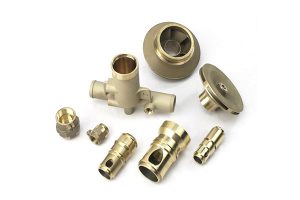Different Types of Investment Casting Materials
Investment casting can produce a wide variety of products and prototypes, but it is important to choose the correct investment casting material for your application. The right material helps you get the desired functionality, save on the cost of materials, eliminate unwanted casting defects, and limit the need for secondary processes after the casting is complete.
 Final parts can display smooth surfaces and dimensional precision while allowing for lower weight, thin walls, or other beneficial properties. Determining which properties can be successfully incorporated into your part largely depends on material choice.
Final parts can display smooth surfaces and dimensional precision while allowing for lower weight, thin walls, or other beneficial properties. Determining which properties can be successfully incorporated into your part largely depends on material choice.
Investment Casting Materials
There is a large selection of alloys to choose from during the material selection process for investment casing. These include:
Stainless Steel
Stainless steels feature superior durability in comparison with many other materials. The potential of the material has led to increased use in investment casting by designers and engineers. Applications for stainless steel include gearbox parts in automotive applications, various gears, camp components, and golf club heads.
Low Alloy Steel
Low alloy steels are among the most frequently used steels in the mechanical world due to their affordability and beneficial mechanical properties. Specialized heat-treating processes make it possible to engineer parts that have differing properties in different areas of the same workpiece. For example, varying heat treatments can be used to make one surface tough and impact-resistant, while another surface becomes wear-resistant.
Aluminum Alloy
Aluminum alloy is the most used material in investment casting. Industries that use it most frequently include aerospace, avionics, electronics, and military.
Castings are now offered for demanding applications like airframe components thanks to the material’s improved strength and the availability of quality castings made from aluminum-silicon-magnesium alloy.
Carbon Steel
Carbon steel is a common low-cost material that comes in a variety of grades, with the classifications varying based on the amount of carbon content. The strength, ductility, and performance of carbon steel can be improved in industrial applications through heat treatment. Its ferromagnetic properties make carbon steel useful in motors and electrical appliances. It is safe, durable, and has a high structural integrity, making it one of world’s most frequently used alloys.
Super Alloy
Super alloys based in nickel and cobalt have common uses in the aerospace, energy, medical, chemical, and marine industries. Nickel-based alloys are stronger at high temperatures and cobalt-based alloys have superior corrosion, oxidation, and wear resistance over their nickel-based counterparts. Super alloys increasingly replace sheet metal because they provide high rigidity and superior service characteristics while remaining a cost-effective option.
Copper Alloy
Copper-based alloys are corrosion-resistant and feature low rates of wear. They are frequently used in applications such as ship or pump propellers, electrical components, and plumbing components. A versatile material, there are more than 400 different alloys featuring a wide variety of properties.
Many part types can be investment cast from copper-based alloys. More common types of copper-based alloys include bronze and brass. The strongest copper alloy is beryllium-copper, which has similar properties to high-strength alloy steels but with a higher corrosion resistance over longer periods.
Cast Iron
Iron castings, which often include gray iron and ductile iron, are known for their high accuracy and an affordable price tag. Ductile iron has high strength, heat-resistance, and toughness, but it has a more complex production process than other steels. This leads to a higher production cost than cast steel.
Investment Casting from Impro
Investment casting materials have different properties and uses, which is why it is important to choose the correct casting material for your application. Proper material selection will ultimately help you achieve the desired functionality of your design while minimizing cost and material waste.
For more information on material selection, or to learn about our investment casting services, please contact us or submit a request for information.
